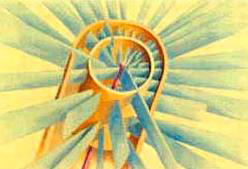Having a few green leaves on the end of a branch does not indicate health, prosperity or longevity. Such remnant green leaves are simply living on the residue of previously stored carbohydrates.
A tree’s crown is composed of many iterations of branches, twigs and leaves. In the formation of a branch the bud bursts and the terminal growth extends leaving a series of leaves in its wake. This new growth and developing leaves are initially parasitic on the parent plant. Carbohydrate (starch) is produced through the process of Photosynthesis. However, this growth is sustained by starch produced by previous growth periods, where surplus carbohydrates are stored in specialised tissues. It is mobilised “Unloaded” from the storage sites and transferred upward for use by the tissue above.
On new leaves and branches, as they extend, side shoots develop at some distance behind the growing tip. The leaves on these branches remain parasitic until they have fully matured, it is only then that they produce more energy than they use. All sections of the tree use energy, as does every living cell that is respiring, it is consuming energy. Once the leaves are mature excess starch may be produced and this travels down through the plant filling “Loading” all the starch reservoirs, as it heads towards the roots.

The Diagram to the right shows the Ray Tissue radiation out from within the tree connecting old and new trees. These connections are broken as a result of wounding. The tissue present before the wound event is no longer available to the trees life processes.
For starch to reach the roots, to sustain their and the Mycorrhizal roots energy needs, all of the starch storage places down the length from production to the root tips must be full. See this as a series of layer upon layer of champagne glasses all stacked up to form a giant pyramid. The top glass is where the champagne is introduced. As the top glass overflows the champagne spills into the glasses that support it. As they fill the process continues until all the glasses are filled right to the bottom of the pyramid.
If there is not enough champagne to fill all the glasses then only the upper glasses will become full and no champagne will get to the bottom glasses. Starch storage is just like this, in that each storage area must be filled before the next lower storage site is filled. What is more difficult to conceptualise is that each iteration, branch or trunk is a separate entity, Trees 1 and Tree 2.
Imagine a tree composed on one central dominant trunk, with many main large branches deriving from this trunk and a series of small branches out along the side branches, the length of these are progressively shorter as you near the current year’s growth. These side branches also have lateral branching.

The diagram to the right shows just such a stylised tree. The red arrow showing a recently formed branch with no lateral, Current growth period.
The Green arrow shows a lateral – Last Growth Period, with sub lateral Current Growth Period and the Blue arrow shows a well-established branch with many sub laterals and other lateral iterations. One two and three Growth Periods.
For a branch to continue to receive water and nutrients it must contribute to the total well being of the tree. Assuming that water and nutrients are available in adequate proportions, if the three arrowed branches, all produce enough starch to fill all the reserve sites within their structure, they will receive full supplies of water and nutrients.
If the green arrow iteration, say as a result of shading from above, does not fill all its starch reserves it will not supply starch to the branch to which it connects. If the same is the case for the blue arrowed major branch, then it also will not supply starch to the trunk. In both these cases, the growth rate of the tissue, in those sections, will be lower than that of the next lower section. This will see the production of a “collar” at the base of each of the underperforming iterations.
The collar has the effect of cutting off, progressively, the amount of water and nutrients that reaches that iteration above the collar. This reduction in resources sees a reduction in starch produced, and respiration
demand exceeds production. This results in further reduction in secondary thickening (Growth rate) of the iteration due to tissue starvation. The section this iteration connects to continues to grow at the normal rate, the result asymmetric growth causing the collar to accentuate. Finally the iteration becomes disconnected from the symplast (active live conducting tissue).

In the picture to the right, the section has had the bark removed. Dr Shigo shows how the trunk tissue grows around the base of the branch. You can see a ridge or raised area that wraps around the branch stub. If this branch (a stub in the picture) had been contributing to the trunk, there would be no ridge at the interface between the sub branch and the trunk.
If this disconnection process continues, the collar will form a point at which the branch will be shed. The connection between the branch and the trunk reduces and the trunk over grows the branch. This area is rich in moisture and oxygen and soon becomes colonised by wood rotting organisms leading to the failure of the branch, shedding, at this point.
The distribution of finite water and mineral resources to the most energy productive tissues is how the tree manages the balance between resources and energy production. Within the life of a tree, there are two stages of management; dieback and decline. See article on these.
